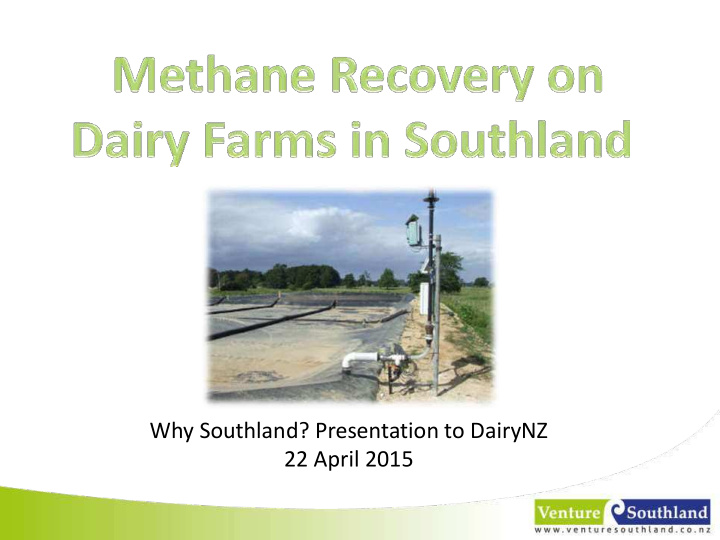



Why Southland? Presentation to DairyNZ 22 April 2015
• 2007 Energy Efficient Dairy Sheds • 2011 Southland Energy Strategy • 2012 Waste to Energy Report • Focus of the 2012 Southland Energy Forum • Dairy Methane Recovery from Effluent Ponds • Dairy LEAN Programme
• Provides onsite generation of electricity and reliable power supply for the farm. • Produces hot water from generator exhaust manifold • Aids the removal/reduction of effluent organic solids through settling and anaerobic digestion. • Captures of odour and the capture and effective use & reduction of Green House Gas emissions. • Optimises the successful conversion bio-waste for on farm energy use. • Ensures that fertiliser rich digested sludge can be returned to the soil. • Can provide insights into the effectiveness of the feed various herbage and feed systems . • Focus on Farm practices, productivity, resource efficiency, minimisation of resource use and farm profitability.
Southland has the lowest average ambient air temperature of all the dairy producing regions therefore, if you can successfully implement this system in Southland you can build similar systems anywhere else in New Zealand and it is likely that these installations will be even more successful.
NIWA monitoring trail was established at a site in Dacre in 2012 to measure the methane production from dairy farm effluent storage ponds in relation to climate, season and the organic loading of the pond to improve the estimation of methane and potential beneficial use as an energy source. Consistent • High purity methane production • Higher than expected methane discharges Core Objectives of the Methane Recovery System: • Simple & reliable • Fool proof • Provides biological resilience • Reduces emissions & retains nutrient on farm • Provides energy redundancy • Affordable
Streamlining the process and developing a general standard or specification for the methane recovery system for a range of different dairy farms . In order for this to happen, we need to build a profile for the following parameters Type 1: Grass feed system with wintering off farm *Type 2: Grass and supplementary feed on covered feed pads *Type 3: Grass and supplementary feed in covered wintering shed *Potentially high peak biomass loading and less diluted effluent
• The establishment of demonstration of a project which provides farmers with the confidence to embrace the type of system that is being developed and trialled locally. The aim is to encourage farmers that are seen as dairy industry leaders as early adopters of this system. • 950 cow dairy farm located on Limestone Plains Road in Southland. • Farmer recognized for environmental leadership • Traditional, predominately grass based system , with little supplement feed used. The effluent management system at the farm is based on a low application sprinkler system (K-line), applying cow shed effluent over up to 200ha of pasture land. Prior to land application, effluent is stored in a clay lined, 60 day capacity storage pond , which is located approximately 100m form the cow shed. Other than a sand trap there is currently no effluent pre-treatment • Early adopter of Dairy Lean Program • Low Water use 20,000litres per day with 15,000litres of reuse
Pond dimensions of 30.6m x 26.2m
Early Construction Phase - Installation of sludge removal ports, inlet and outlet structures
Pond ¾ full with gas Collection ring main sitting in place. Currently waiting for liner to be installed
Gas Storage under the pond cover
System Schematic Water-trap and gas Pond cleaning Heat exchanger - hot water Fan Electricity Interface
Questions?
Recommend
More recommend